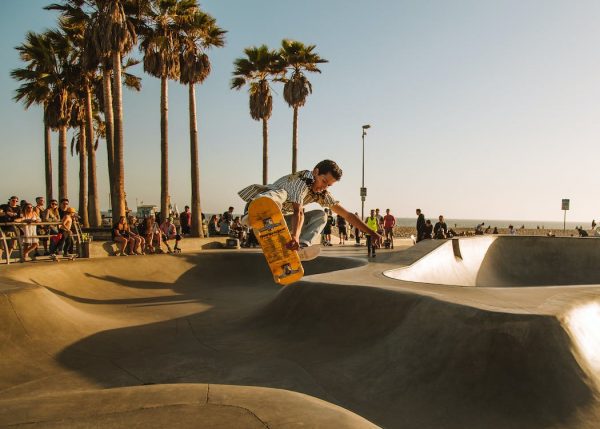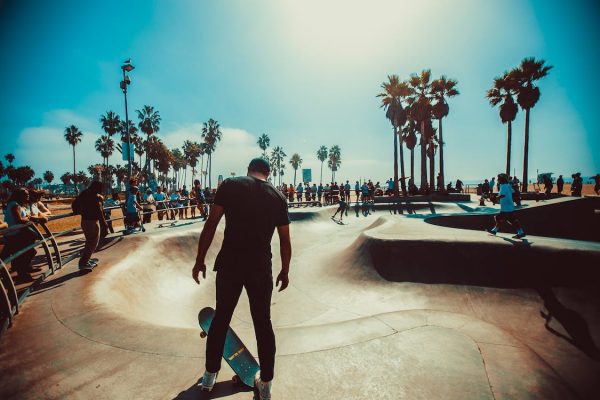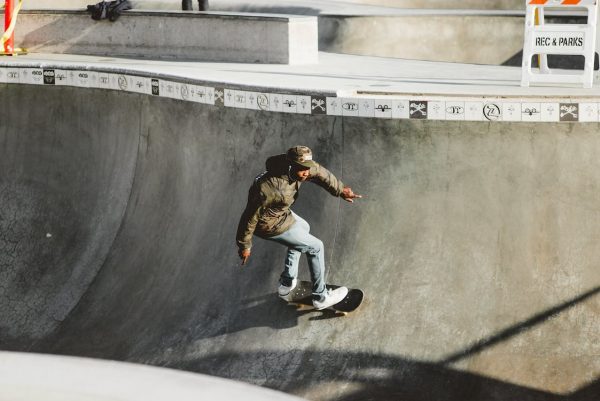The skateboarding society is a social phenomenon that is a part of the sporting world. Let’s learn more about the subcultures of riding skateboards.

At FamilyHype, we believe that the family unit is the foundation of a thriving society. As such, we are thrilled to explore the depths of unity in diversity through the vibrant street skating.
This adrenaline-pumping sport is a universal language that connects diverse groups, each with its own distinct style. From street skating with its urban playgrounds to vert skating that takes thrill-seekers soaring to heights or longboarding, which offers a smooth ride closer to nature – these vibrant skating subcultures make up the eclectic tapestry of skateboarding.
We invite you to join us on this journey to uncover the family-oriented good values, sport careers, service, sports journal, and community spirit at the heart of skateboarding culture. Furthermore, we will examine how a skating subculture influences the dominant skater culture and its future.
Key Takeaways
- As we explore the various skating subcultures, we are reminded of the beauty of unity in the diversity of skateboard riding or street skating. Although each skateboard group is unique, they are all unified by a shared love for skateboarding.
- Street skaters, park skaters, longboarders, downhill skaters, and more have distinct styles, cool tricks, events, and lifestyles, yet are connected by a common culture. From skateparks to street spots to DIY ramps, skateboarders worldwide come together to push the boundaries of skater culture.
- We will learn more about how skateboarding or street skating impacts society and its future. The spirit of skateboarding – freedom, creativity, and resilience – is encapsulated within this variety.
- As skateboarders, we share a unique bond. No matter where we come from, we are punks. Whether it’s the thrill of executing a new trick, exploring new terrain and public spaces, or simply enjoying the camaraderie among friends, street skating is an experience that unites us all.
Let’s continue to come together to share our love of skater groups. FamilyHype encourages all to join us in celebrating this special skateboard community and the unity found within its diversity.
Skateboarding History
When it comes to the history of skateboarding, it’s a thrilling tale of how skateboarding became popular from the sun-kissed public beaches of Southern California in the late 1950s, not just as a sport or hobby but as an emblem of counterculture and freedom global. Before skateboarding comes to a time of its popularity, it was first called sidewalk surfing by people and media. The invention of urethane wheels that started to replace clay wheels on a wooden skateboard in the 1970s also changed how people skated. The Z-Boys (Zephyr Team) also began to make waves at this time. Pioneering skateboarders truly revolutionized the youth team, serving others by promoting unity, diversity, and other core values within skating unique subculture.
Skateboarding activism has emerged as a dynamic force in the new era of late capitalism, combining cultural politics and cultural studies with social resistance. Becky Beal participates in exploring diverse voices and social issues within subcultural media, which can be found in her international journal and books about skateboards. Today, skateboarding can also now be studied in various aspects including its impact on sociology and the community.
As we can see, skateboarding is a sport that requires a wide variety of skills and knowledge. Though most people didn’t have access to skateboarding, skateboard riding is a great way for people to connect and express themselves for free. Thus, many did their best to have one.
Street Skateboarding Subculture
The street skateboarding subculture is a vibrant community filled with self-expression and creativity. This unique skateboard group will thrive in urban environments, where concrete landscapes become an exhilarating playground for daring tricks and camaraderie that transcends boundaries. A distinct street fashion and an unwavering love for the sport unite early skaters and members of this diverse community.
At the core of the street skateboarding group is the skateboard itself. There are many styles and types of contemporary skateboarding for guys and gals out there, from small popsicle-style skateboards to larger cruiser boards. Additionally, street skateboards often feature a variety of accessories, such as custom grip tape, wheels, bearings, and trucks. All these components come together to create a skateboard unique to each rider.
Regardless of skateboard style, all skateboarders share a common passion for the sport. Skateboarders create a positive and accepting environment filled with respect and unity. So, if you’re looking for a thrilling and unique experience for you to enjoy, join the street skateboarding group today as a skater as this is one of your rights- to enjoy!
Source: pexels.com
Skateboard Riding Evolution
As we delve into the dynamic world of the ramp or vert skateboarding subculture, it’s impossible to ignore the skateboard’s profound impact on the evolution of skateboarding and the professional skateboarding scene.
Ramp riding has undergone a radical transformation over the years, demonstrating an incredible blend of creativity, innovation, and sheer determination that continues to reshape our idea of what’s possible on a skateboard. This skateboard subculture has birthed some of the greatest pro skaters in skateboarding history, significantly influencing how we perceive and appreciate this thrilling sport.
The Evolution Of Ramp Riding
The evolution of ramp riding has been a thrilling ride, beginning with simple homemade structures and evolving into complex skateparks that challenge even the most experienced skaters. This growth was driven by advancements such as ramp construction techniques, artistic influences on ramp design, safety measures, and professional skateboarding as a profitable mainstream sport. These transformations not only spurred creativity but also contributed to the broader acceptance of this group.
Impact On Professional Board Riding
Professional skateboarding has been revolutionized by the evolution of ramp riding, like the X Games competition in the 1990s. Skateboard riding has pushed athletes and other skaters to hone their skills and provided lucrative sponsorships and various competitions. These sponsorships help promote gender inclusivity within this dynamic subculture. Aside from this, this skater culture has also seen the emergence of new factors such as streetwear, skate parks, and a skate video.
The popularity of skateboarders like Tony Hawk, Tony Alva, and Rodney Mullen also gave rise to new tricks and a larger community. This encouraging environment fosters a fun, healthy, and safe roller skate experience for the youth and has profoundly impacted the ever-evolving skateboarding scene. However, many say that skateboarding’s popularity and winning money go against the original values of the skateboard subculture.
Skateboard Subculture: Longboarding Society
In our exploration of the subcultures of skateboarding, we’re now diving into the world of longboarding.
Notably different in style and approach from traditional skateboarding, longboarding is characterized by its unique blend of speed, balance, and freestyle maneuvers. We can’t wait to uncover the laid-back lifestyle of longboarders immersed in a skater culture that cherishes camaraderie and freedom as much as skill and innovation.
Skateboarder’s Style On Skateboards
You’ll find that most groups are as varied and unique as the skaters themselves, each boasting distinctive styles, approaches, and attitudes. The fusion of skateboard artistry with fashion creates an inspiring, vibrant blend. These differences help us appreciate our passion for serving others through skating, whether it’s daring tricks or creative skateboard designs.
Skate Subculture Lifestyle
Longboarding isn’t just a sport. It’s a way of life for many, with its unique style and outlook. Longboard construction itself is an art that reflects the surfer’s and rider’s personalities. Mastery of longboarding techniques helps us glide smoothly through life’s twists and turns. Roller skate riding teaches us resilience, camaraderie, and the joy of serving others. These lessons prove invaluable in understanding skateboarding’s broader societal impact.
It’s important to remember that skateboard riding is more than just a sport or hobby but an opportunity to build friendships and share experiences among other skaters who also love to skate. We hope you can take something away from this article and use skateboarding to build a strong connection with the skateboarding community.

Skateboards & Society
Skateboarding’s impact on society is far-reaching, breaking barriers and bringing together individuals and teens from various walks of life. We’ve seen the influence of skateboarding fashion, with its unique style reflecting our shared central values and other subcultural values.
Skateboarding music also unites us, giving voice to our collective spirit. This melting pot of skateboard diversity illustrates how we can serve others through shared passions and interests. From roller skate decks to grip tape to bearings and wheels, skateboarding culture offers a variety of components that make up the whole.
Skateboard Riding Future
Having explored the societal aspects of skateboarding, let’s now turn our gaze toward what lies ahead. With advancements in skateboarding technology, we’re poised to break new ground while reducing skateboarding injuries.
We believe that the future of skateboarding is not just about tricks and flips but also about fostering community and unity amid diversity. Together, we can carve a path forward in promoting safety, inclusivity, and family values through skateboarding. So, let’s join together and explore the possibilities that the future of skateboarding holds.
Subculture Of Skateboard Riding: Conclusion
The skateboarding subculture in the United States has thrived as a vibrant youth culture, shaped by iconic figures like Tony Hawk and fostered within the confines of skate parks. Exploring skateboard riding subculture sites reveals the dynamic evolution, shifts, and professional skateboarders who have left an indelible mark on these unique and enduring skate subculture sites and shifts.
Our exploration of the various subcultures of skateboarding serves as a poignant reminder of the remarkable unity within skateboard riding diversity. While each skater subculture possesses its distinctive characteristics and identity, they are all bound together by a deep and unwavering passion for the sport of skateboard riding.
Within the expansive realm of skateboard riding, we encounter an array of styles and disciplines, encompassing street skaters who thrive on navigating urban landscapes, park skaters who conquer intricate skatepark courses, longboarders who revel in smooth and flowing rides, and downhill skaters who chase exhilarating speed descents. Each facet of skateboarding carries unique techniques, tricks, and lifestyles, yet what unites skateboard riders is a shared skater culture and camaraderie.
From the bustling skateparks to the hidden gems of street spots and the creative world of DIY ramps, skateboarders from every corner of the globe converge to continuously push the boundaries of what can be achieved in skateboarding. Regardless of our origins, backgrounds, or chosen styles, skateboarders share an unparalleled connection and bond that transcends geographical borders, forging a tight-knit community that celebrates the sheer joy and artistic expression of skateboarding.
Let’s continue to come together to share our love of skateboard riding. We invite you to join us in celebrating this special community and the unity found within its diversity. We hope you can share your experience and opinions with us and read more of our series articles in the blog page.
FAQs:
What Is Skateboarding Subculture?
One of the best sports, skateboarding developed into a youth skater subculture that celebrates creativity and uniqueness. Skateboard riding became an alternative to more organized, mainstream sports. Usually girls and boys consisted of this. Subculture is prominent in universities as well, take for example the Grinnell college. In the Grinnell college, skateboarders are separated into separate groups, the hardcore or serious skaters, the skaters, and skater affiliated. The
Grinnell college is just one example of how skateboarders have subcultures as well.
What Are The Different Skateboard Styles?
Skateboarding enthusiasts explore diverse styles to suit their preferences and skills. Some popular skateboarding styles for boys consisted freestyle, vert skateboarding, park skateboarding, street skateboarding, downhill skateboarding, off-road skateboarding, and cruising.”
Why Do Skaters Dress Like That?
Many skateboarders opt for baggy clothing primarily for comfort, as skateboard riding allows unrestricted movement during their tricks and maneuvers. Additionally, they often choose clothing made from durable materials that can withstand the rigors of skateboarding, ensuring their attire holds up well over time.
What Is Street-Style Skateboarding?
Street-style skateboarding is a discipline within skateboarding where skateboarders perform tricks (Ex. ollie) and maneuvers in urban environments, utilizing various elements commonly found on streets, such as ledges, stairs, handrails, curbs, and other obstacles.
What Is A Goofy Rider?
A sign that a skateboarder is a goofy rider is he keeps their right foot at the front of the board, using their left foot to push. “Regular riders” do the opposite.
Which Foot Do You Push With On A Skateboard?
This depends entirely on what you’re more comfortable with. There’s no hard rule dictating which foot should go where. Always practice in places such as skateparks or empty pool. Just take into account that you should also give some space for other skaters to practice as well.
How Do You Know Which Foot Is Dominant?
Determining your dominant foot, often called your “stance” in various activities like skateboarding, snowboarding, or even martial arts, can be important for your balance and control. Here’s a simple test to help you figure out your dominant foot in skateboarding:
- The Slide Test: Stand on a smooth surface (like a hardwood floor or a tile) in your bare feet. Stand up straight with your feet close together.
- Relax: Close your eyes and take a moment to relax. Try to find your natural balance.
- Start Sliding: Without overthinking about it, have someone gently push you from behind so that you start to slide forward.
- Observe: Pay attention to which foot moves forward first to catch your balance. The foot that instinctively moves forward is likely your dominant foot.
In most cases, if your right foot moves forward first, you are right-foot dominant (regular stance). If your left foot takes the lead, you are left-foot dominant (goofy stance).
Remember that your dominant foot can also influence your stance in activities like skateboarding or snowboarding. In skateboarding, for example, if you’re right-foot dominant, you might prefer a regular stance where your right foot is at the back of the board. If you’re left-foot dominant, you might prefer a goofy stance with your left foot at the back. However, some individuals may also find that they feel more comfortable with their non-dominant foot at the back, so it’s not a strict rule.
Ultimately, the goal is to find your most natural and comfortable stance in your chosen activity. Always practice in places such as skateparks or empty pool.
How Do You Become Fearless On A Skateboard?
The only way to gain confidence while skateboarding is by practicing in a safe environment and always wearing protective gear. Always practice in places such as skateparks or empty pool.
How Do I Stop My Skateboard From Turning Left?
Check your urethane wheels and trucks if you feel like your board is turning in a certain direction. Your urethane wheels may be too worn down on one side, or your trucks might be loose.
Why Can’t I Balance On A Skateboard?
Maybe you didn’t have access to balance yet. Start by adjusting your stance. Observe proper foot positioning and keep your knees slightly bent. You’ll also want to keep your core engaged. Don’t get frustrated if you can’t get skateboard riding right at first. Learning how to skateboard takes a lot of time and practice. Always practice in places such as skateparks or empty pool.
Last Updated on July 6, 2024 by Jayvel De Guzman
DISCLAIMER (IMPORTANT): This information (including all text, images, audio, or other formats on FamilyHype.com) is not intended to be a substitute for informed professional advice, diagnosis, endorsement or treatment. You should not take any action or avoid taking action without consulting a qualified professional. Always seek the advice of your physician or other qualified health provider with any questions about medical conditions. Do not disregard professional medical advice or delay seeking advice or treatment because of something you have read here a FamilyHype.com.